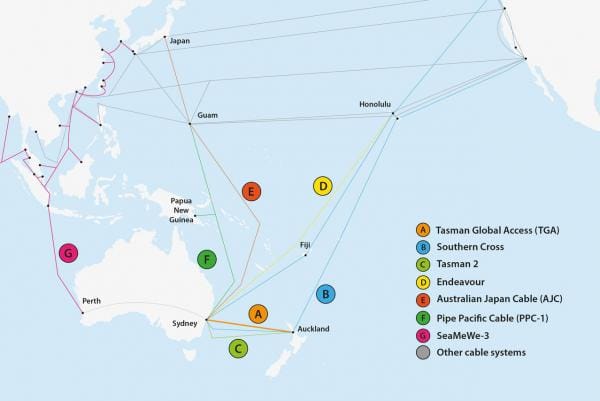Telecom, Vodafone promise Auckland-Sydney cable

Telecom NZ, Vodafone and Telstra plan to build a new submarine cable linking New Zealand to the east coast of Australia. When completed in mid to late 2014, it will be the second major broadband link between New Zealand and the rest of the world.
The companies say the project will cost less than US$60 million and will include three fibre pairs for a total capacity of 30TBps – that’s around 300 times the current data demand.
Telecom NZ is 50 percent owner of the rival Southern Cross Cable network, so there are question marks over whether the new cable will do much to increase competition. Nevertheless, bringing Vodafone and Telstra into the ownership ensures Telecom NZ doesn’t have monopoly control over New Zealand’s international data links.
Filling the submarine cable void
Comment: It was clear from the moment Pacific Fibre closed down last August that someone would move to fill the submarine cable void. This joint venture from Telecom NZ, Vodafone and Telstra effectively sees off any other projects which may or may not have been planned. Building a new submarine cable is a smart move on their part: taking control of their own future and not waiting for someone else to control it.
Although some argue New Zealand needs a direct trans-Pacific link to the west coast of the USA, that falls into the category of a nice-to-have luxury and not essential. Investors weren’t convinced of Pacific Fibre’s $400 million business case.
Building a link to Australia was always the most cost-effective option. About 40% of NZ traffic goes across the Tasman and the relative rise of Asian economies compared to the USA means the route to our west will eventually be more important than the route to the east.
Latency
The lower latency promised by Pacific Fibre’s direct link between NZ and the USA is far less important than having a second network. And anyway, much of the data used by New Zealanders is cached in Sydney so arguably a second Tasman will mean as much of a speed boost for most users.
It’ll be interesting to see how the joint venture partners go about selling access on the new cable and how they’ll treat New Zealand’s smaller ISPs and data users. There’s unlikely to be any regulatory oversight – which makes some commentators uneasy. The joint venture structure, together with the structure of Southern Cross Cable Network should deliver some competition.
One last thought – and a question for informed readers – is where does this leave Chorus? You might expect the largest network company to want a role in one or more of the international networks. And with Telecom effectively sitting upstream and downstream, does this leave the company in a difficult strategic position?
Member discussion